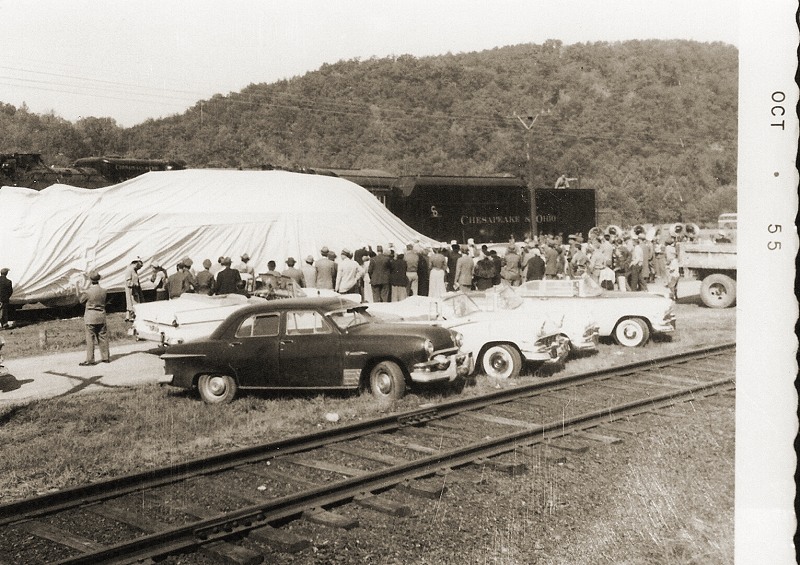The Dennison Railroad Depot Museum is undertaking a special project to restore an old steam engine.
DENNISON It’s been long enough.
After waiting 20 years, Chesapeake & Ohio (C & O) Steam Engine Number 2700 will undergo restoration.
The
engine is currently situated at the east end of the Dennison Railroad
Depot Museum after being transported from Canton in August 1997.
The
cosmetic restoration will be done on site within Dennison’s Historic
District, part of the Downtown Dreamsville USA Corridor linking the
village of Dennison and the city of Uhrichsville.
The engine
restoration is an Ohio Department of Transportation local Enhancement
project, largely funded by ODOT with matching contributions from
Dennison, the Reeves Foundation, the Harold C. and Marjorie Q.
Rosenberry Foundation, the Leggitt Foundation, the Doris and Floyd
Kimble Foundation, the Tom E. Dailey Foundation, the Brach Foundation,
the Tuscarawas County Community Foundation and Wendy’s. After a public
bidding process, the job was awarded to Gemini Industrial Machines of
Dover, owned by Jason Johnson.
In a press release issued by the
Dennison Railroad Depot Museum, Johnson stated that the cosmetic
restoration will include sandblasting and painting to the originally
built paint scheme. Johnson has 20 years of experience restoring
engines and explained, “many of the missing parts will have to be
recreated and placed on the locomotive.”
The work is expected to be done by late fall. The project is estimated to cost around $150,000.
Museum
Director Wendy Zucal explained that “the engine is known to be one of
the most stripped engines in the country: missing gauges, valves, name
plates, driving rods, windows, bell and whistle. Most of these are lost
forever and will have to be recreated.”
And restoring it won’t be easy, she added.
“There
were many obstacles in the road challenging the completion of this
project,” Zucal said. “The Depot restoration had to be completed first,
funding had to be raised twice and ownership had to be proven twice.
Although it has taken far longer than ever anticipated, the community
and museum have shown tremendous tenacity to keep the engine
restoration on track.”
Engine’s story
The engine’s story
began in World War II when the C & O turned to the 2-4-8 wheel
arrangement to handle the fast freight schedule war demanded. The 2700
was the first engine of a group of 90 class K-4, 2-8- 4 “Kanawha”
locomotives, the name coming from the Kanawha River which paralleled
the C & O Main line. These engines were built by the C & O
between 1943 and 1947 — 20 from the Lima Locomotive Works and 70 from
the American Locomotive Company. The locomotives were numbered 2700
through 2789.
The very first steam locomotive in the Kanawha
series was Dennison’s 2700. Specifically, the 2700 was built by the
American Locomotive Company at Schenectady, N.Y. in 1943 – making it a
wartime engine and perfect for the Dennison Depot Museum’s period of
interpretation. Fourteen K-4 engines were built by the C & O in
1942, and they were numbered 2700 – 2713. All these locomotives had
69-inch diameter drivers, 26-inch-by-34-inch cylinders, a 245 psi
boiler pressure exerting 69,350 pounds of tractive effort. Together,
the engine and tender weigh 850,000 pounds, or 425 tons.
By
1952, the C & O had enough diesel engines that it began to retire
the Kanawhas, though they still had service tine. By 1957, all were
retired. All but 13 that were donated to various cities were scrapped.
The
2700 was retired in 1956 and placed on display in Coonskin Park in
Charleston, W. Va. for many years where it was vandalized. The 2700
next moved to St. Albans, W. Va. in the 1970s where it was restored by
the St. Albans Fire Department. In 1986, the engine was brought to Ohio
by a group known as S.T.E.A.M. (the Silver Throttle Engine Association
Museum) in Canton, where a full restoration was planned. The engine was
located on the Esber Beverage spur near Timken. Parts were removed for
repair and storage, but the restoration never came to fruition.
Left
abandoned on a spur that the Wheeling and Lake Erie Railroad wanted to
remove, the engine was saved at its very last hour from the scrapyards
by local steam engine enthusiast and collector Jerry Jacobson, owner of
the Ohio Central Railroad, who moved the engine to Dennison where it is
now part of the Museum’s historical collection.
Funding for
restoration was raised by the Dennison Depot in an earlier ODOT
Transportation project, but those funds had to be diverted to the Depot
restoration as engine ownership was questioned in two court cases in
2009. The Depot won the case and the following appeal.
Understanding the engine
As a railroad museum, Zucal explained that a steam engine on display is critical.
“Kids
need to stand next to a steam engine to understand the power and
strength of the railroad that built our country and changed the tide in
many wars,” she explained.
The museum strategically planned a
static freight train headed by a yard Thermos Bottle Engine on the
Depot’s west side and a museum wing of passenger cars headed by the
2700 on the Depot’s east side to provide interpretative comparisons
between freight and passenger trains for visitors.
Anyone
interested in continued support of the Engine 2700′s upkeep is
encouraged to join the Museum as a member of the 2700 Club. The annual
cost is $27, and includes all member benefits. For information on
membership and the Depot’s full calendar of events, please go to
DennisonDepot.org, email customerservice@DennisonDepot.org, follow the
museum on Facebook, or call 740-922-6776.
The Dennison Depot
which is a National Historic Landmark, designated for its role as a WWI
and WWII servicemen’s Canteen that served 1.5 million soldiers.
Dennison is known as “Dreamsville USA”, a nickname it received during
the forties for its Servicemen’s Canteen that served 1.5 million
soldiers, 13 percent of all armed personnel.
From the Ohio Times Reporter |

